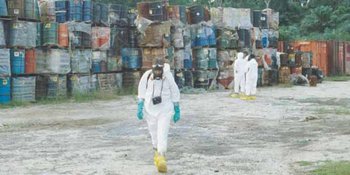14.4 Conventions on hazardous wastes
What is hazardous waste?
Hazardous waste is waste that is potentially harmful to people or the environment by, for instance, being toxic, explosive, flammable or corrosive. (You learned about the definition of hazardous waste in Study Session 1.)
Hazardous wastes cause a range of damage to humans, such as infections, toxicity to the body, burns to skin and eyes, and cancerous changes in the body and in genetic material. Industrial processes, mining industries and healthcare facilities are the main sources of these wastes.
Waste materials such as toxic chemicals are exported by some countries for treatment or disposal in other countries (Figure 14.4). This is dangerous and is likely to cause environmental pollution and health problems in the receiving countries. The export of hazardous wastes from industrialised to developing countries was highlighted by a case in 1987 where Italian companies exported 18,000 barrels to a local farmer in Nigeria for storage. It was later found that the barrels contained hazardous waste, including polychlorinated biphenyls. The waste was eventually sent back to Italy, but that led to protests in Italy as Italian ports did not want to handle the hazardous material.

Experiences like this Italian case led to increased awareness and recognition of the need for international agreement about the proper handling of hazardous waste. The Basel Convention (Convention on the Control of Transboundary Movements of Hazardous Wastes and their Disposal) was the output of a series of negotiations on the management of hazardous waste. It was adopted in 1989, came into force in 1992, and currently involves 166 countries. The convention provides guidelines for the sound management of hazardous waste using waste optimisation and the assurance of this principle when exporting such wastes to a country.
The Basel Convention encouraged regional agreements on hazardous wastes. Concern over the export of hazardous wastes to African countries led to the Bamako Convention, which has the full title of Convention on the Ban of the Import into Africa and the Control of Transboundary Movement and Management of Hazardous Wastes within Africa. The main aims of the Bamako Convention (UNEP, n.d. 1) are to:
- prohibit the import of all hazardous and radioactive wastes into the African continent for any reason
- minimise and control transboundary movements of hazardous wastes within the African continent
- prohibit all ocean and inland water dumping or incineration of hazardous wastes
The Convention was adopted in 1991 and came into force in 1998. It was originally negotiated by 12 countries of the African Union and has since been ratified by 25 African countries (African Union, 2013).
14.3 Conventions and agreements on climate change
